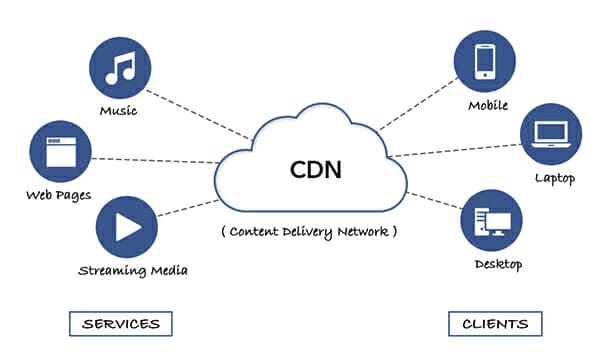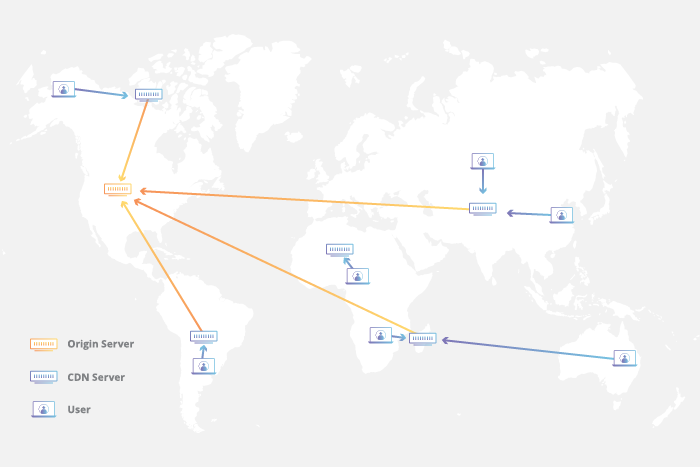
At its core, a Content Delivery Network (CDN) is a network of servers linked together with the goal of delivering content as quickly, cheaply, reliably, and securely as possible. In order to improve speed, latency, and network connectivity, a CDN will place servers at the exchange points between different networks.
These Internet exchange points (IXPs) are the primary locations where different Internet providers connect in order to provide each other access to traffic originating on their different networks. By having a connection to these high-speed and highly interconnected locations, a CDN provider is able to reduce costs and transit times in high-speed data delivery and low-latency content distribution.

Latency – How Does A CDN Improve Website Load Times?
When it comes to websites loading content, users drop off quickly as a site slows down. CDN services can help to significantly reduce load times in the following ways:
- The globally distributed nature of a CDN means reduced distance between users and website resources. Instead of having to connect to wherever a website’s origin server may live, a CDN lets users connect to a geographically closer data center. Less travel time means faster service and improved page speed.
- Hardware and software optimizations such as efficient load balancing, solid-state drives (SSDs), and smart caching can help data reach the user faster.
- CDNs can reduce the amount of data that’s transferred by reducing file sizes using tactics such as minification, GZIP compression, and image optimization. Smaller file sizes mean quicker load times and better user experience (UX).
- CDNs can also speed up sites which use TLS/SSL certificates by optimizing connection reuse, enabling TLS False Start, and reducing handshake times.
Explore all the ways a CDN helps websites load faster and boosts overall performance metrics.
Reliability And Redundancy – How Does A CDN Keep A Website Always Online?
Uptime is a critical component for anyone with an Internet property, whether it’s a personal blog or a large-scale eCommerce platform. Hardware failures and spikes in traffic, as a result of either malicious attacks or just a boost in popularity, have the potential to bring down a web server and prevent users from accessing a site or service. A well-rounded CDN has several features that will minimize downtime and maximize service availability:
- Load balancing distributes network traffic evenly across several servers, making it easier to scale rapid boosts in traffic and prevent single points of failure.
- Intelligent failover provides uninterrupted service even if one or more of the CDN servers go offline due to hardware malfunction; the failover can redistribute traffic to the other operational servers.
- In the event that an entire data center is having technical issues, Anycast routing transfers the traffic to another available data center, ensuring that no users lose access to the website.
Data Security – How Does A CDN Protect Data?
Information security is an integral part of a CDN strategy. A CDN can keep a site secured with fresh TLS/SSL certificates, which will ensure a high standard of authentication, encryption, and data integrity. In addition, CDNs are often equipped with Web Application Firewalls (WAF), DDoS mitigation, and bot protection tools to handle modern security threats.
Investigate the security concerns surrounding CDNs, and explore what can be done to securely deliver content at scale. surrounding CDNs, and explore what can be done to securely deliver content.
Source: Cloudflare
See More Resources
What is a CDN? | Cloudflare Learning Center
https://www.cloudflare.com/learning/cdn/what-is-a-cdn/
Comprehensive guide to understanding CDNs, provided by a leading CDN service provider.
CDN Guide | Akamai
https://www.akamai.com/solutions/intelligent-edge-platform/cdn
In-depth overview of how CDN technology works at the edge of the network.
How Does a CDN Work? | AWS CloudFront Documentation
https://docs.aws.amazon.com/AmazonCloudFront/latest/DeveloperGuide/Introduction.html
Technical documentation from Amazon explaining how CloudFront CDN delivers secure and fast content.
CDN Optimization Techniques | Google Cloud
https://cloud.google.com/cdn/docs/optimizing-performance
Best practices from Google on improving performance and reducing latency using CDNs.
Understanding TLS and CDN Security | DigiCert
https://www.digicert.com/blog/why-using-a-cdn-makes-tls-ssl-better
Security insights into how CDNs enhance encryption and secure communication online.

